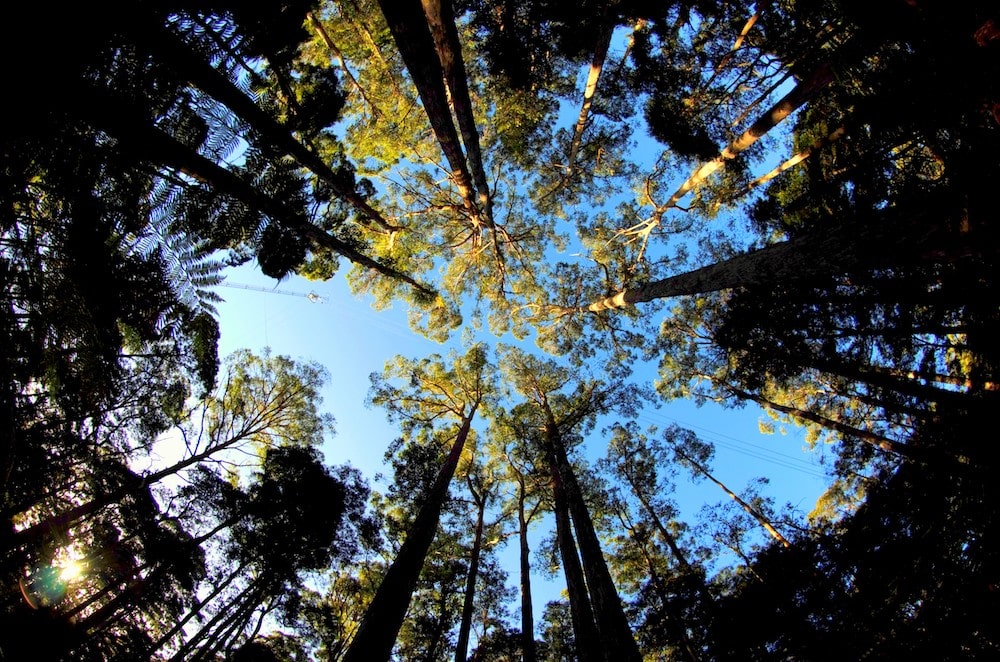This month our site feature takes us to Australia’s most southerly flux monitoring site, located in one of the world’s tallest and most productive forests. For almost a decade, equipment at the Warra site has been measuring the exchange of carbon, water and energy between the atmosphere and the tall eucalypt forests that dominate this biodiverse and immensely valuable wilderness region.
Established in 1998 and part of TERN since 2013, TERN’s Warra Tall Eucalypt SuperSite is Australia’s oldest Long Term Ecological Research (LTER) site.
Situated in one of the most productive terrestrial ecosystems in the world, in the cool, temperate wet forest biome, the site uniquely spans environmental, altitudinal and socio-ecological gradients, from the ancient gondwanic alpine conifer forests to the lowland new world temperate eucalypt forests.
It extends from the Tasmanian Wilderness World Heritage Area in the west to the public native forests managed for timber production in the east.
Data collected by TERN ecosystem research infrastructure at the site have facilitated a plethora of research, from understanding the fundamental ecological processes and dynamics in tall wet eucalypt forest, and detailed baseline monitoring of biota including the cryptic species, to multidisciplinary research aimed at understanding the responses of this biota to natural wildfire disturbance processes compared to anthropogenic disturbance regimes.
The ecological understandings coming out of the site are also being used to guide Sustainable Timber Tasmania’s forest retention strategies and native forest harvesting plans and help make sure forest management is ecologically sustainable.
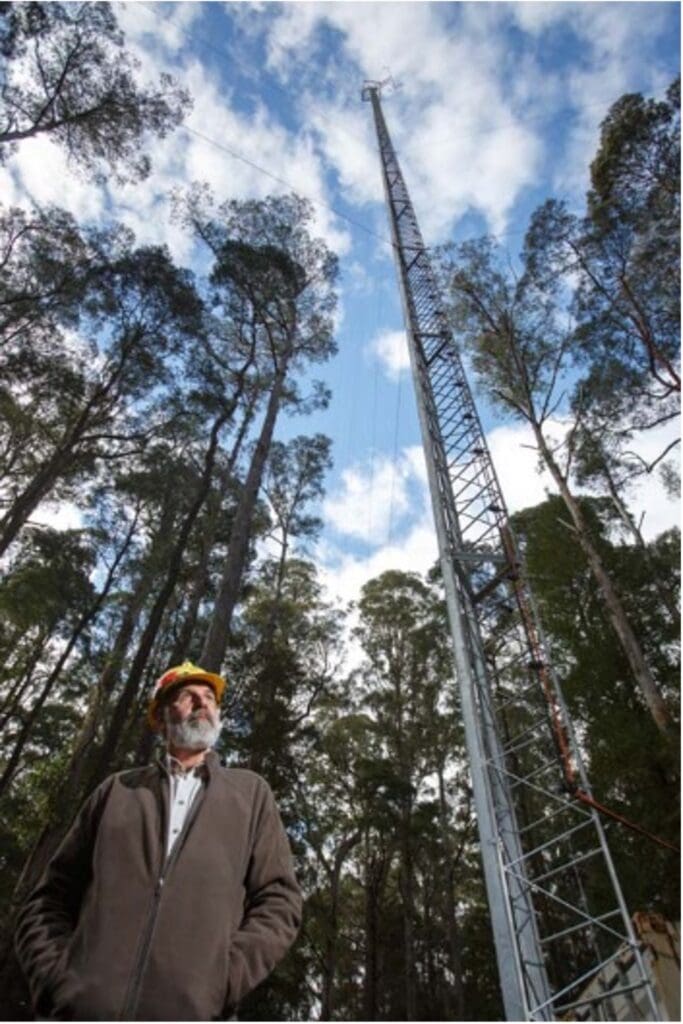
Tim Wardlaw standing at the base of the Warra flux tower (Credit: The Australian)
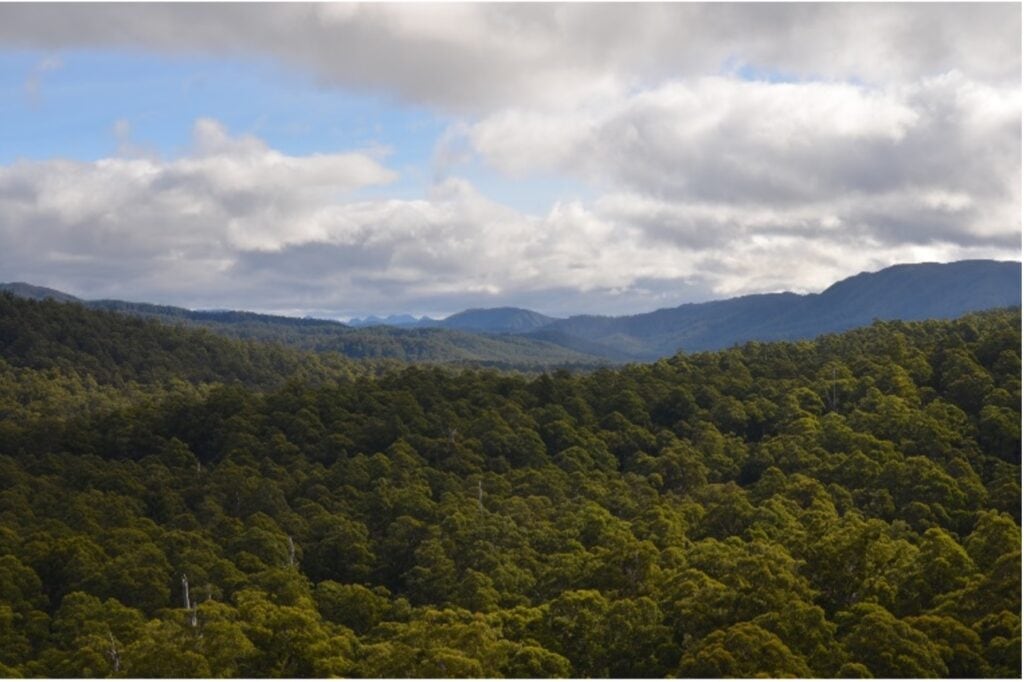
the view west from the top of the Warra tower showing the homogenous forest landscape that surrounds the site (Credit: Tim Wardlaw)
Rich biodiversity and a history of harvesting at Warra
Reaching 80 m height, the ecosystem exchange-monitoring flux tower at Warra—Australia’s most southerly flux monitoring site—is the tallest flux tower in the OzFlux research community’s network, and amongst the tallest in the world.
It extends above a canopy dominated by Eucalyptus obliqua, a tree species that attains a mature height greater than 55 m and can reach up to 90 m under ideal growing conditions. This forest type has occupied the landscape around Warra for at least the last 50,000 years and is at the far southern range of Australia’s temperate forest ecosystems.
The site’s understory is comprised of a mix of wet sclerophyll and rainforest species, including Dicksonia antarctica, Acacia melanoxylon, Nothofagus cunninghamii, Atherosperma moschatum, andPomaderris apetala. The relative abundance of these understory species varies depending on time since fire and the local patterning of fire intensity.
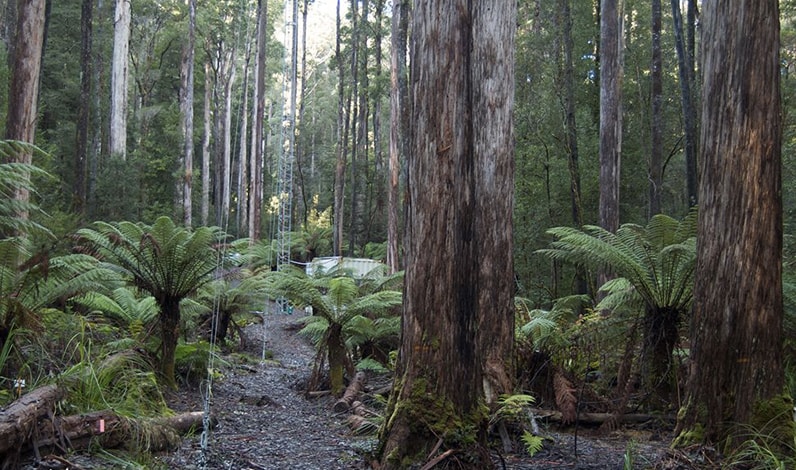
Understory vegetation and woody debris at Warra (Credit: Mirko Karan)
Coinciding with its rich biodiversity is a history of timber harvesting at Warra, which began in the 1970s. Over the years, harvesting practices have been developed and refined to sustainably manage wood production from these highly productive Tasmanian forests, says Dr Tim Wardlaw of the University of Tasmania (UTAS), who manages the site with the assistance of Alison Phillips of Sustainable Timber Tasmania.
“The evolution of our understanding of natural disturbance in the Tasmanian range of tall eucalypt forests is guiding the way forestry is done.”
Dr Tim Wardlaw, University of Tasmania
Sustainable Timber Tasmania, the state forest manager, has even used the research from the site to develop and operationalise the Landscape Context Planning System—a new, novel way of implementing a biodiversity landscape approach.
The system uses GIS technology to enable routine reporting on the environmental and socio-ecological attributes of the landscape at multiple spatial scales, including monitoring land tenure, forest heterogeneity, forest maturity, habitat fragmentation, forest connectivity, and the cumulative effect of past, present and future harvest operations on biodiversity values.
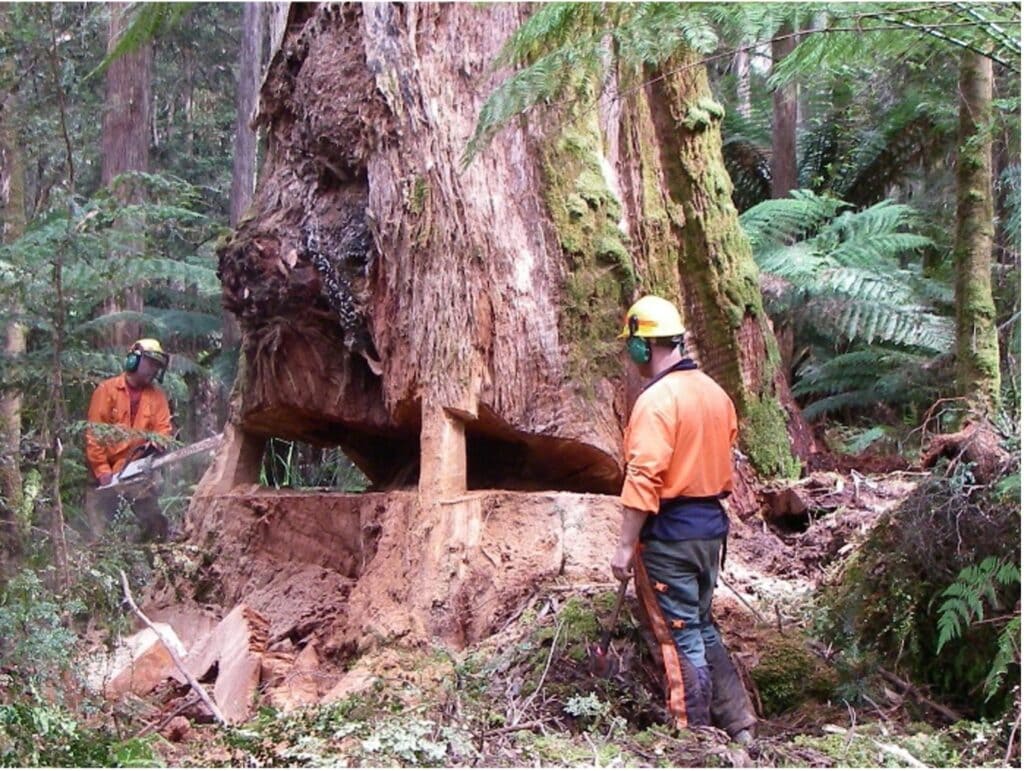
Felling a mature E. obliqua in preparation for erecting the Warra flux tower (Credit: Leigh Edwards)
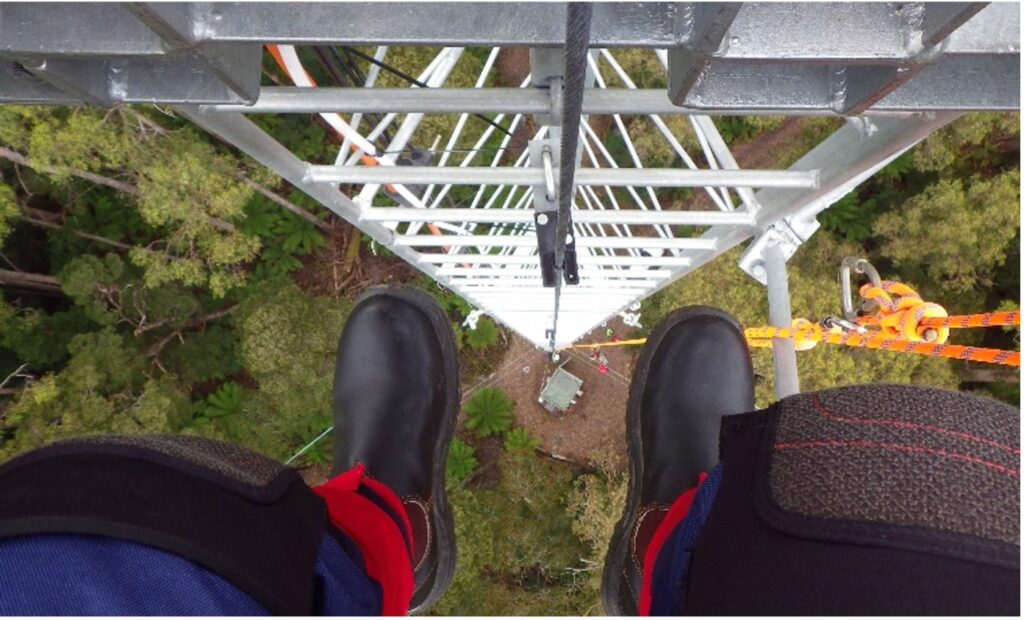
The view looking down from the top of the Warra flux tower (Credit: Cacilia Ewenz)
It’s cool, it’s wet, yet it still burns
The climate of Warra is cool temperate, characterised by mild summer temperatures that peak in January (min. 8.4°C – max. 19.2°C), and cool winter temperatures that reach their minimum in July (min. 2.6°C – max. 8.4°C). It is usually wet to some extent at Warra, with a mean annual rainfall of 1700 mm and no discernible dry season.
Despite the cool and wet climate at Warra, the site experiences periodic disturbance from fire, which shapes and maintains vegetation structure and coarse woody debris inputs to the system. These fires do not typically replace the overstory vegetation, but they are destructive to the understory. While they are a common occurrence in Tasmania’s world heritage forests, little is known about the conditions under which these fires burn or the lasting effects they have on forest recovery and biodiversity.
Research activities at Warra are helping to close this understanding gap, with a recent article published in the journal Fire showing the story through measurements of a fire that burned through the site in January 2019.
The fire started from a dry lightning strike and burnt a total of 64,000 ha of land, including the TERN SuperSite. When the fire hit the SuperSite, air temperature and CO2 emissions peaked before the monitoring equipment shut off due to a burnt power cable.
While the fire itself was considered low intensity, it still consumed fine fuels and ground vegetation and resulted in crown scorch of the understory trees and some of the overstory. This resulted in a sustained reduction in leaf area index in the aftermath of the fire, with the ecosystem switching from a carbon sink before the fire to a carbon source post fire as the ecosystem recovered.
The flux tower survived the fire, but a large amount of NCRIS-enabled TERN monitoring infrastructure was destroyed. Soil sensors, bio-acoustic recorders, dataloggers, power and communication cables, either melted or irreparable. The nearby iconic Tahune Airwalk, almost completely ruined.
Thanks to massive efforts by TERN and site partners, Sustainable Timber Tasmania, Tasmania Parks and Wildlife Service and the University of Tasmania, the site was quickly made safe and most of the equipment reinstalled. By Winter 2019, scientists like Dr Tim Wardlaw (UTAS), were back at TERN’s Warra Tall Eucalypt SuperSite conducting post-fire research to assess fire impacts and ecosystem recovery.
“We have been waiting for two decades to measure and monitor a natural fire event in the forests at Warra from time-0. TERN’s infrastructure has provided unprecedented detail of the fire event and changes it caused to the forest.
We now have a quality time-series dataset on the exchanges of water and carbon from the site’s flux tower before, during and after the fire event, which was the first in this forest since 1898!
Such data are very rare globally and may challenge some of our assumptions about carbon losses during fires.
When combined with the extensive information on soils, vegetation structure and composition and species occurrence collected on the ground by TERN, these data are immensely valuable for understanding the functioning and resilience of Australian ecosystem to fire.”
Dr Tim Wardlaw, University of Tasmania
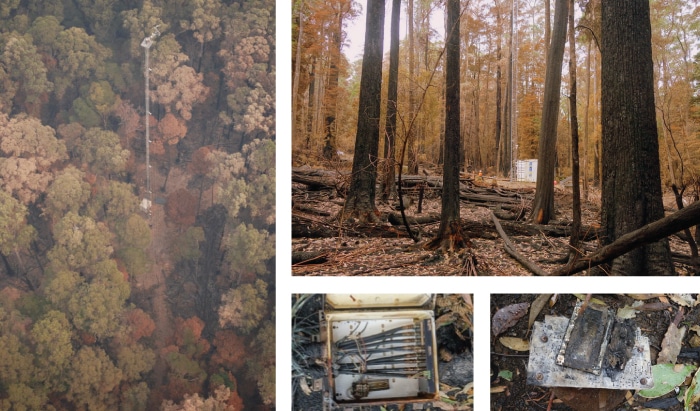
The aftermath of the 2019 fire at Warra (Credit: Marti Piesse and Tim Wardlaw)
- TERN acknowledges the Palawa and Pakana people (Tasmanian Aboriginal community) as Traditional Owners of Lutruwita (Tasmania).


